Part of a series of articles titled Volcano Types.
Previous: Maars and Tuff Rings
Article
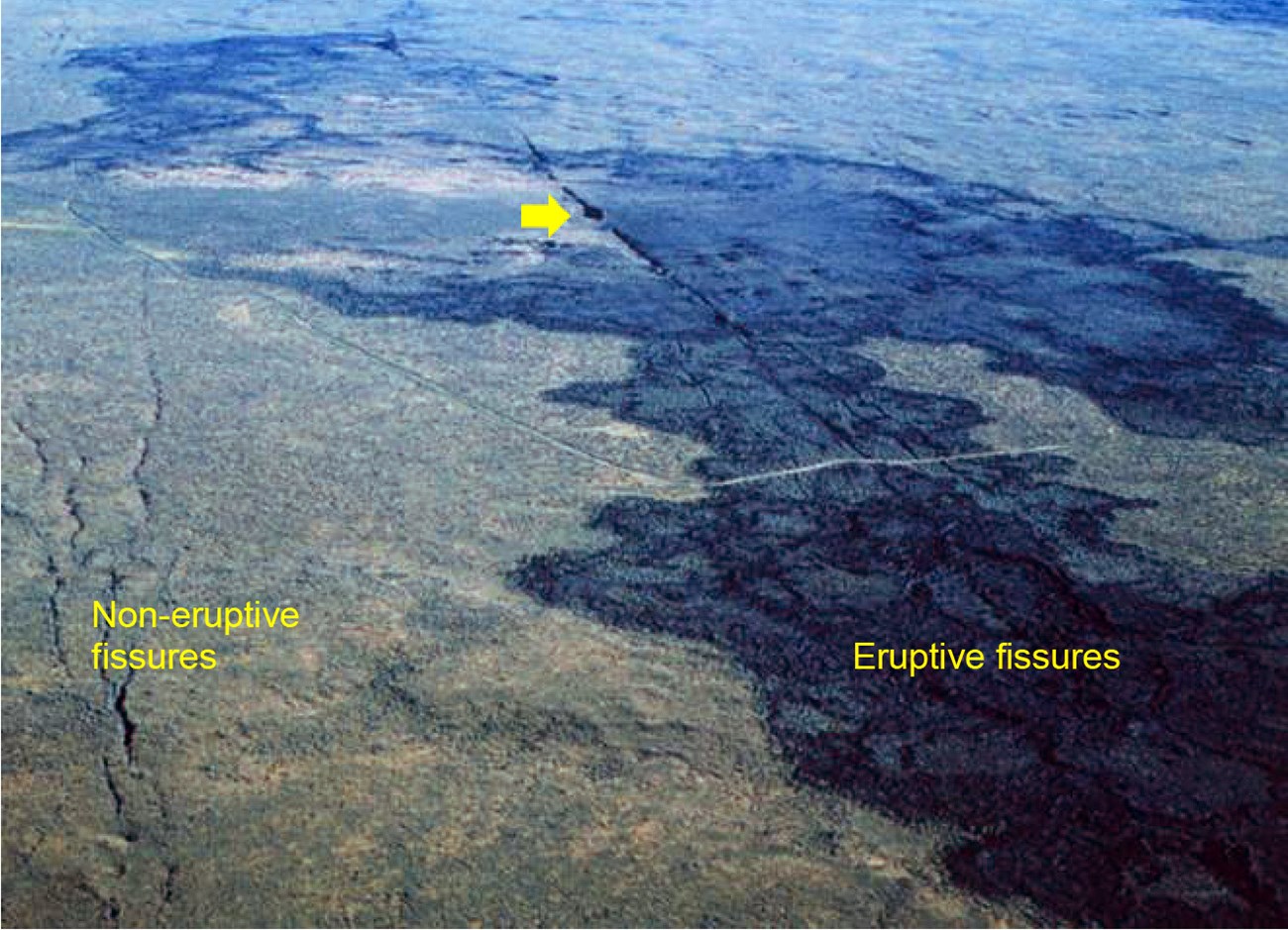
NPS photo by Douglas Owen.
Fissure volcanoes are produced by eruptions that occur along elongated fissures versus at a central vent. Fissure eruptions occur when magma-filled dikes intersect the surface.
Fissure eruptions usually do not build substantial edifices, but instead feed lava flows that can travel great distances. Fissure eruptions may also occur in rift zones on shield volcanoes. They also frequently occur in monogenetic volcanic fields.
Fissure eruptions may be large or small, depending on the magma supply and length of the fissure. Fissure volcanoes have been the site of the largest volume volcanic eruptions in Earth’s history in terms of magnitude of lava erupted.
Fissure volcanoes commonly occur in monogenetic volcanic fields and in other volcanic areas. At least four units of the National Park System contain fissure volcanoes, including:
Craters of the Moon National Monument and Preserve contains three lava fields (Craters of the Moon, Wapi, and Kings Bowl) aligned along the Great Rift on the Snake River Plains in Idaho. Eruptive fissures fed the extensive basaltic lava flows in the park. Cinder cones and spatter cones are also aligned along fissures.
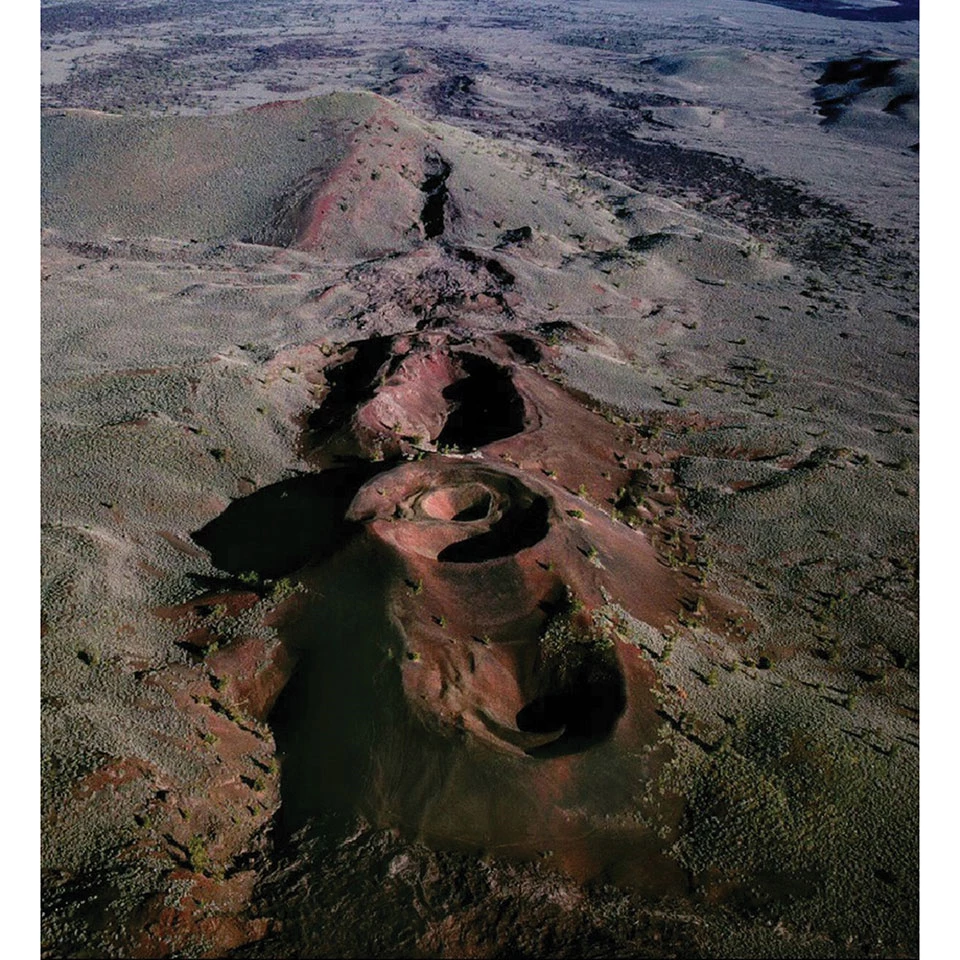
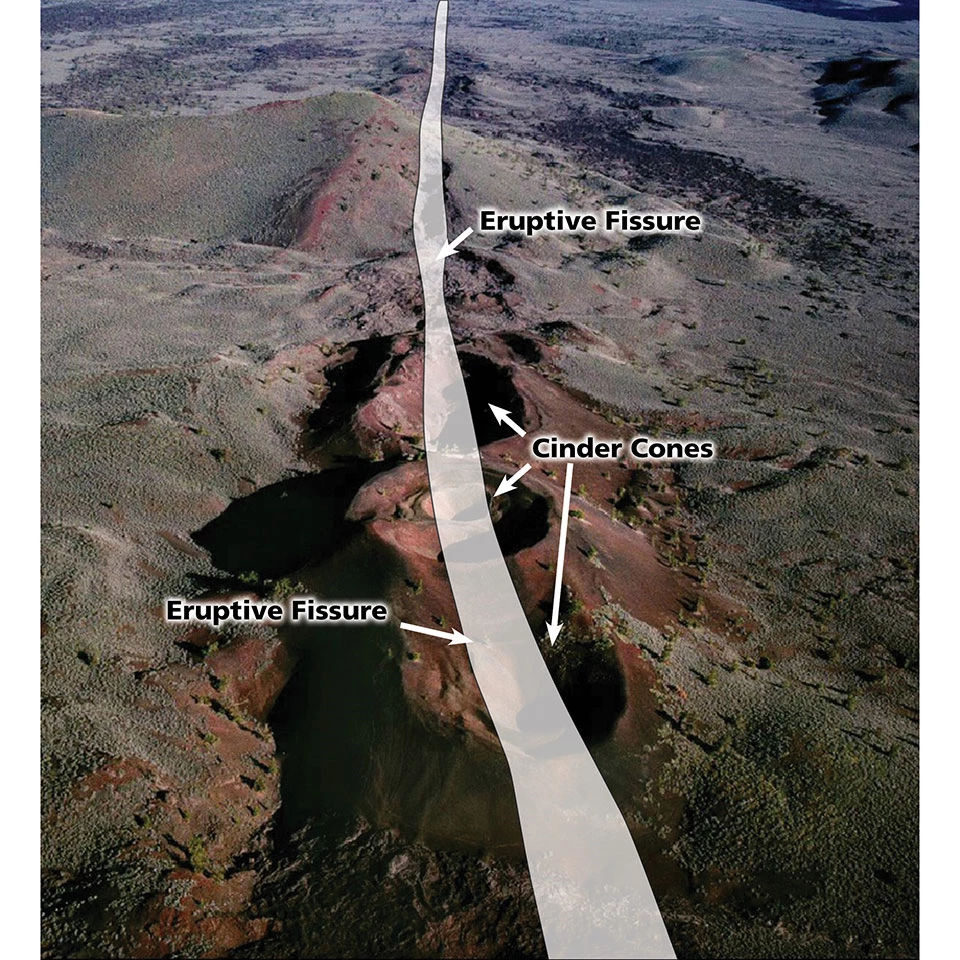
Left image
An alignment of vents along an eruptive fissure in Craters of the Moon National Monument and Preserve.
Credit: NPS photo.
Right image
Image with features labeled.
Credit: NPS photo.
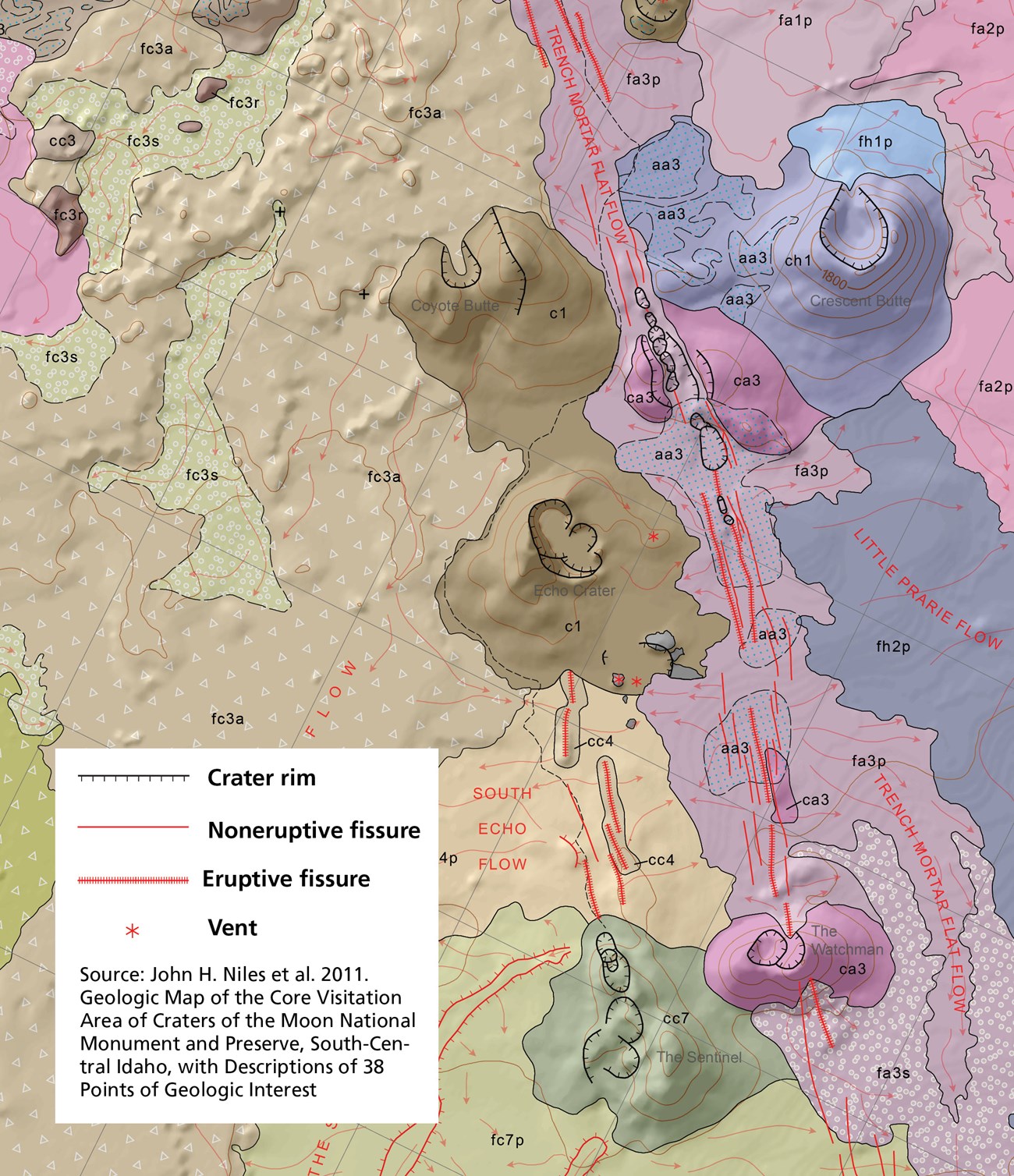
Twin Craters is a series of small cinder cones aligned along a small fissure, and one of the sources for the Twin Craters lava flow, which was erupted approximately 18,000 years ago. El Malpais National Monument contains part of the Zuni-Bandera Volcanic Field, a monogenetic field on the margin of the Colorado Plateau in New Mexico.
Lava Beds National Monument contains a number of lava flows that were erupted from fissures on the flank of Medicine Lake Volcano in northern California, a large shield which is mostly outside of the monument.
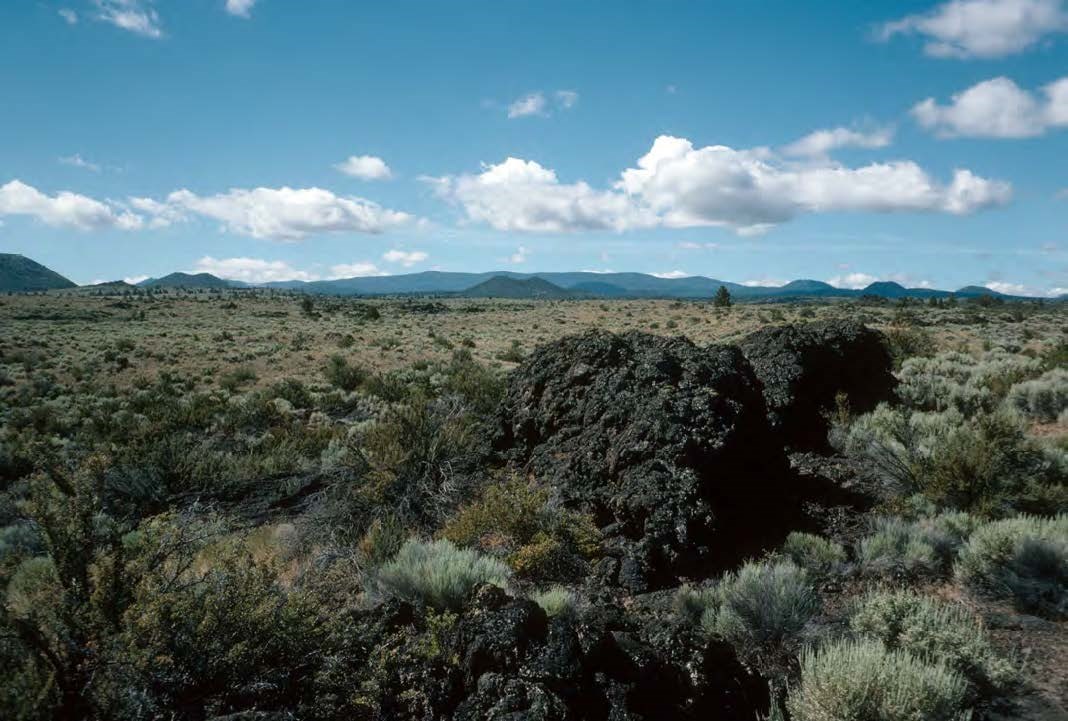
USGS photo.
Petroglyph National Monument is located within the Rio Grande Rift on the west side of Albuquerque, New Mexico, and contains a series of five small volcanic edifices formed along a fissure that erupted approximately 156,000 years ago.
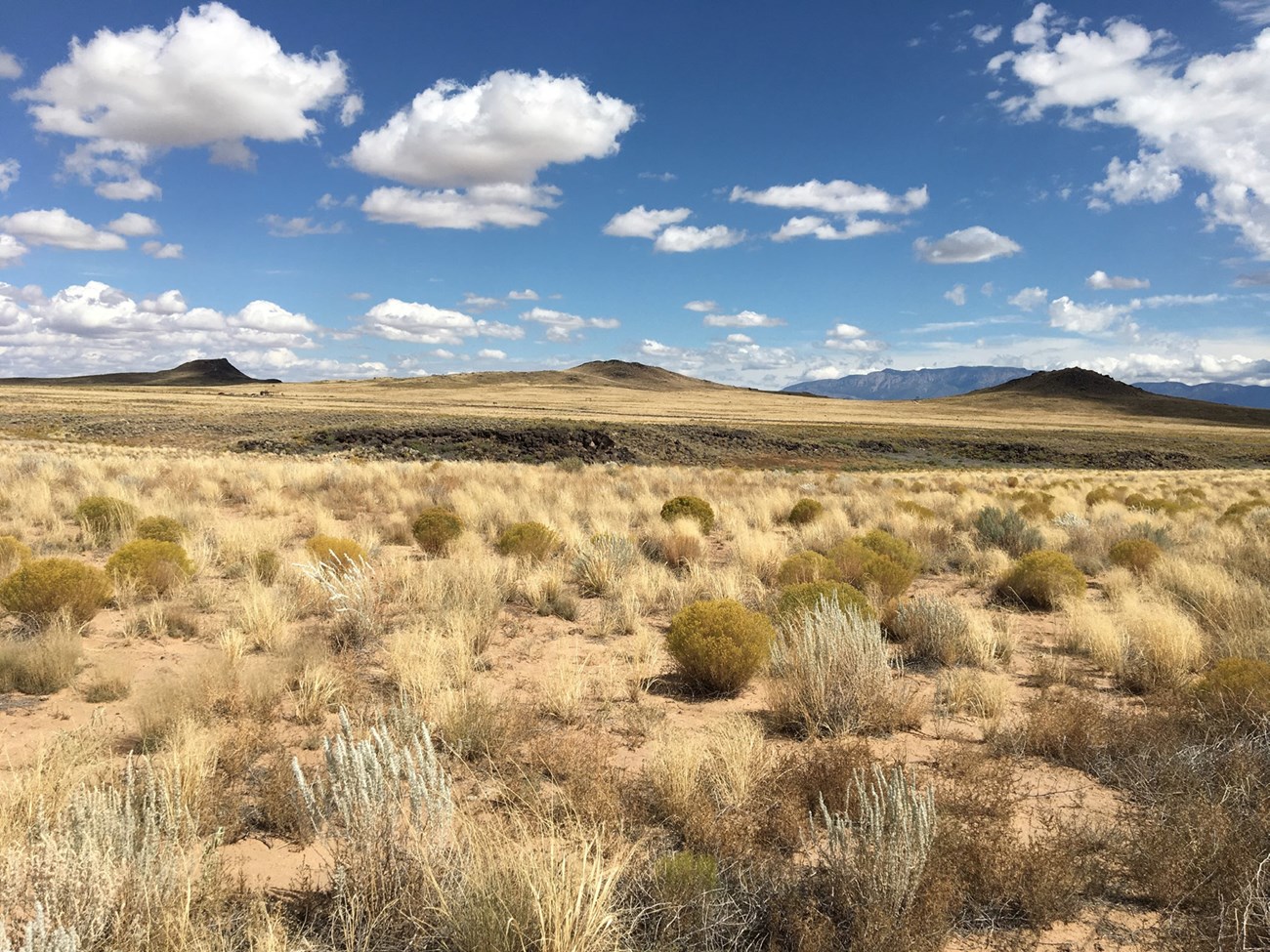
NPS photograph by Chanteil Walter.
Vents for fissure volcanoes are elongated linear features. Eruptive fissures are generally parallel to rifts and other existing fracture systems. Fissure eruptions occur when magma that had injected from deeper magma reservoirs into dikes (tabular igneous intrusions) reaches Earth’s surface.
Fissure volcanoes typically do not have edifices or hills, except for low spatter cones where still-molten volcanic bombs accumulated due to fountaining. Lava flows from fissures may cover large areas with the extent of the lava flows depending on magma supply, viscosity (e.g., more fluid flows can travel greater distances), and eruption rate.
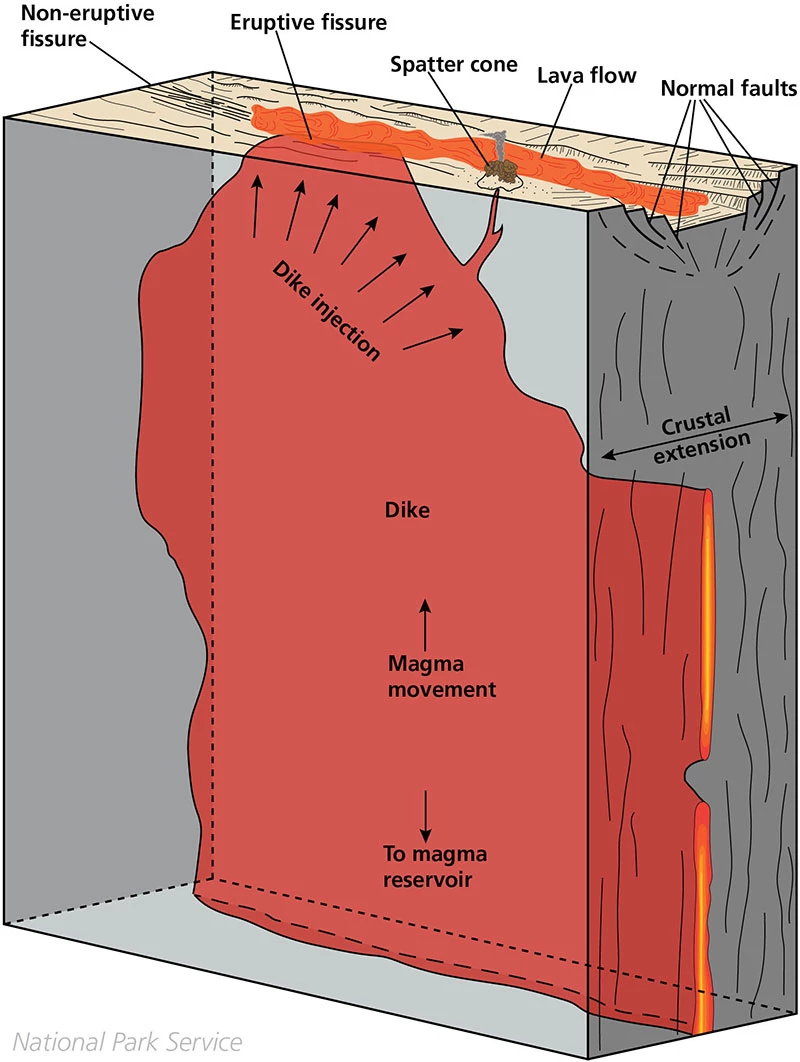
Graphic by Trista Thornberry-Ehrlich (Colorado State University) after Hughes and others (1999) -- Mafic Volcanism and Environmental Geology of the Eastern Snake River Plain.
Most fissure volcanoes erupt basalt to basaltic andesite lavas, although lavas of any composition can be erupted from fissures.
Most fissure volcano eruptions are nonexplosive (Effusive), usually 0 on the Volcanic Explosivity Index (VEI), although they can range up to 1 (Severe). Eruptions of basaltic or other mafic lavas are usually in the Hawaiian style, with lava flows and sometimes fire-fountains being emitted.
Fissure eruptions may emit either small or large volumes of lava. Large-volume fissure eruptions may produce profound environmental consequences due to the large volumes of gas erupted with the lava.
Fissure volcanoes occur in both oceanic and continental environments. In continental environments, they are frequently associated in extensional environments or in monogenetic volcanic fields.
Fissure eruptions also occur on the flanks of shield volcanoes.
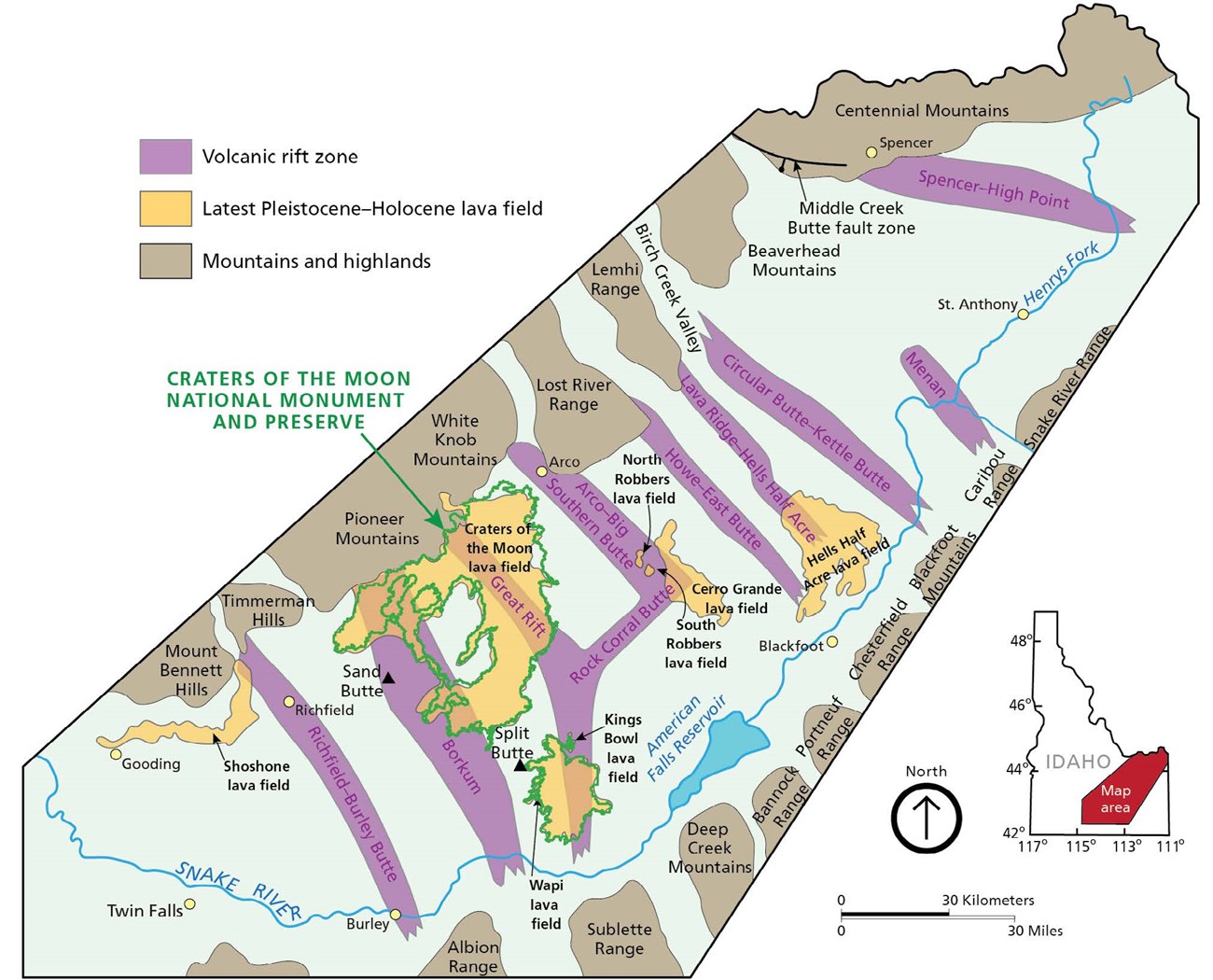
Graphic by Trista Thornberry-Ehrlich (Colorado State University) after Kuntz et al. (1992, figures 2 and 7).
Large shield volcanoes such as Kīlauea and Mauna Loa have active rift zones where fissure eruptions occur. The rift zones are areas of weakness that allow pathways for magma to travel within dikes, leading to flank eruptions away from the summit area.
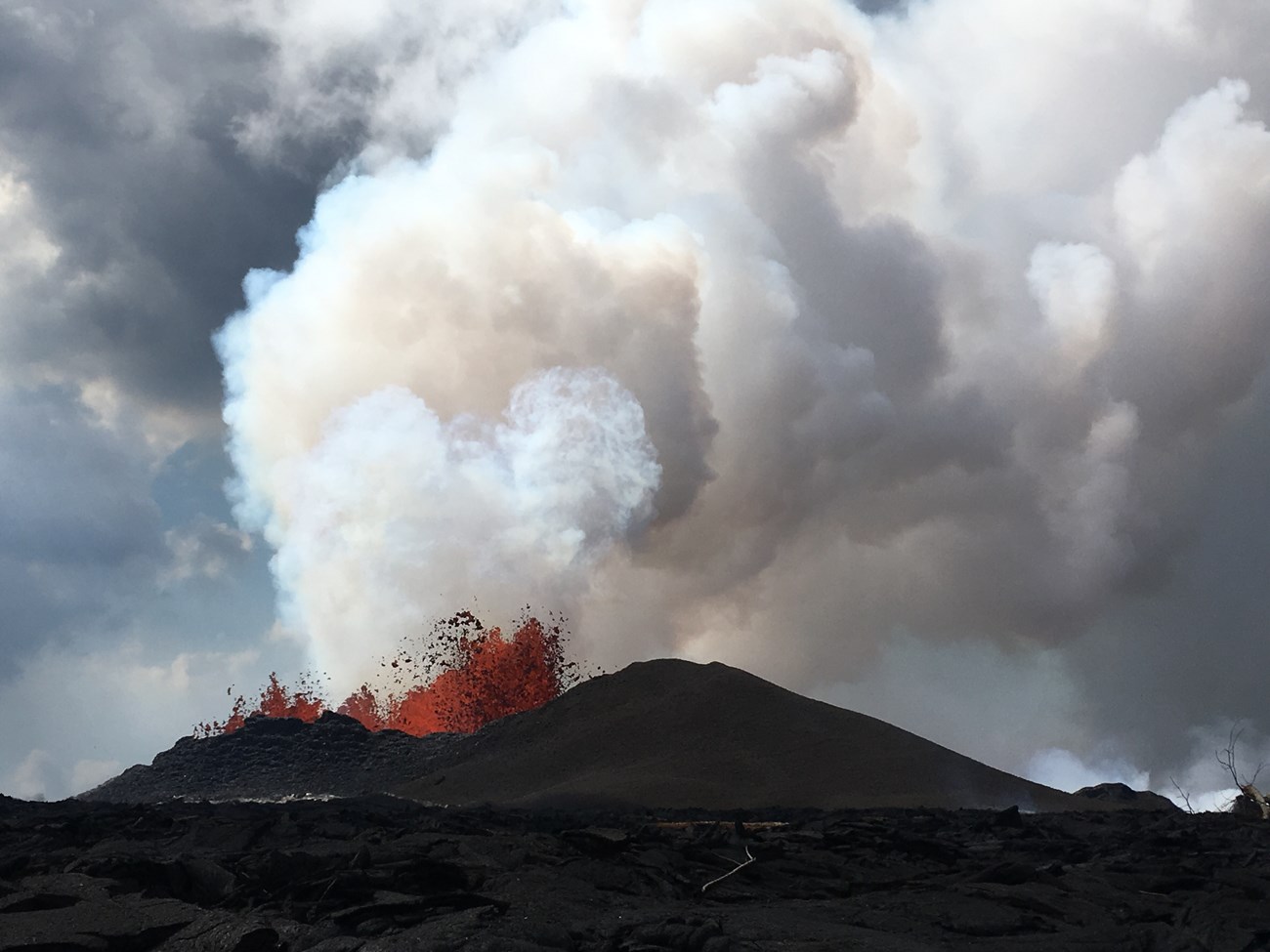
USGS photo.
The Columbia River Basalt Group is the product of the largest eruptions in North America’s history. The Columbia River Basalts are flood basalts (or plateau basalts) meaning that they are thick accumulations of lava flows that were erupted within a short period of time and that cover a vast geographic area.
Columbia River Basalts cover more than 81,000 square miles (210,000 square km), and have an estimated volume of 50,000 cubic miles (210,000 cubic km). They were erupted within a short time period, mostly between 16.7 and 15.5 million years ago.
They were erupted from fissures, mostly in eastern Oregon, southeastern Washington, and Idaho, and accumulations of lava flows up to 13,000 ft (4,000 m) thick filled much of the Columbia Basin, with lava flows traveling as far as the Oregon-Washington coast. The dike swarms that are the source of the Columbia River Basalts have a north-northwest orientation, with fissure lengths reaching as much as 110 miles (180 km).
Columbia River Basalts are found in several NPS sites in the Northwest including Nez Perce National Historical Park, John Day Fossil Beds National Monument, Lake Roosevelt National Recreation Area, and Manhattan Project National Historical Park.
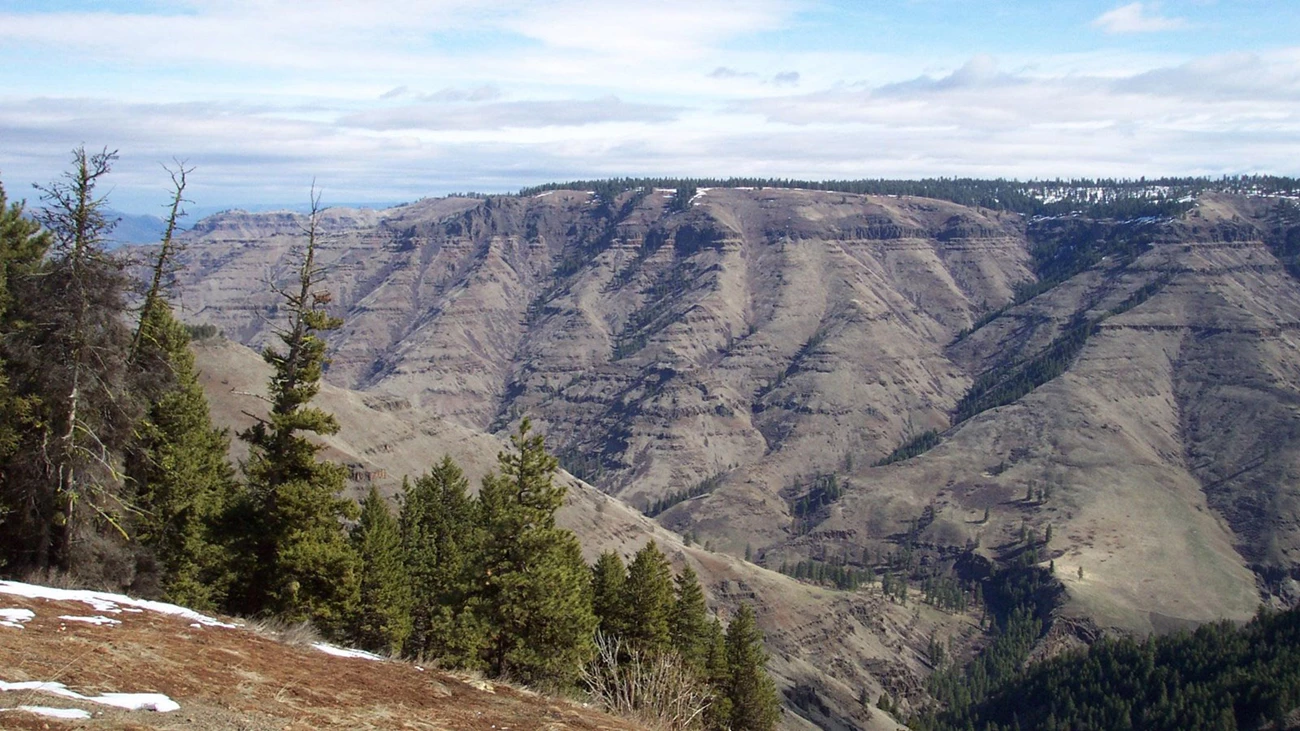
NPS photo.
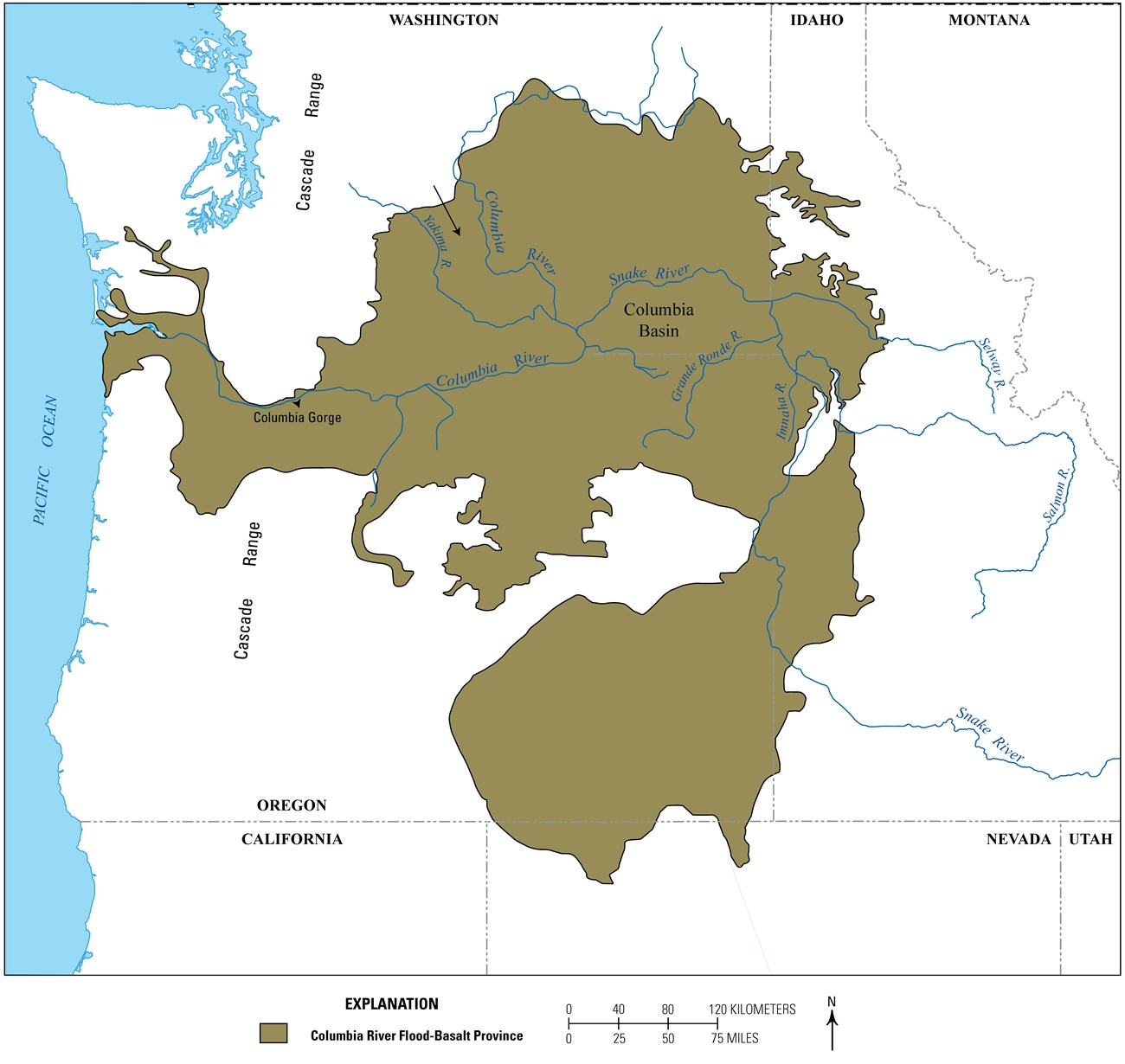
Modified from USGS map.
Fort Vancouver National Historic Site (FOVA), Washington—[FOVA Geodiversity Atlas] [FOVA Park Home] [FOVA npshistory.com]
Hagerman Fossil Beds National Monument (HAFO), Idaho—[HAFO Geodiversity Atlas] [HAFO Park Home] [HAFO npshistory.com]
John Day Fossil Beds National Monument (JODA), Oregon—[JODA Geodiversity Atlas] [JODA Park Home] [JODA npshistory.com]
Lake Roosevelt National Recreation Area (LARO), Washington—[LARO Geodiversity Atlas] [LARO Park Home] [LARO npshistory.com]
Lewis and Clark National Historical Park (LEWI), Oregon and Washington—[Volcanoes of the Lewis & Clark Trail]
Manhattan Project National Historical Park (MAPR), NM, WA, &TN—[MAPR Park Home] [MAPR npshistory.com]
Nez Perce National Historical Park (NEPE), ID, OR, MT, WA—[NEPE Geodiversity Atlas] [NEPE Park Home] [NEPE npshistory.com]
Whitman Mission National Historic Site (WHMI), Washington [Note: the park doesn’t include CRBs, but they are nearby: Whitman Mission—Volcanoes & Floods]
While lavas of any compositions may be erupted from fissures, basaltic lava flows are common. These fluid lava flows can flow great distances from vents in either pāhoehoe and ‘a‘ā forms, although fissures sometimes erupt blocky lava flows.
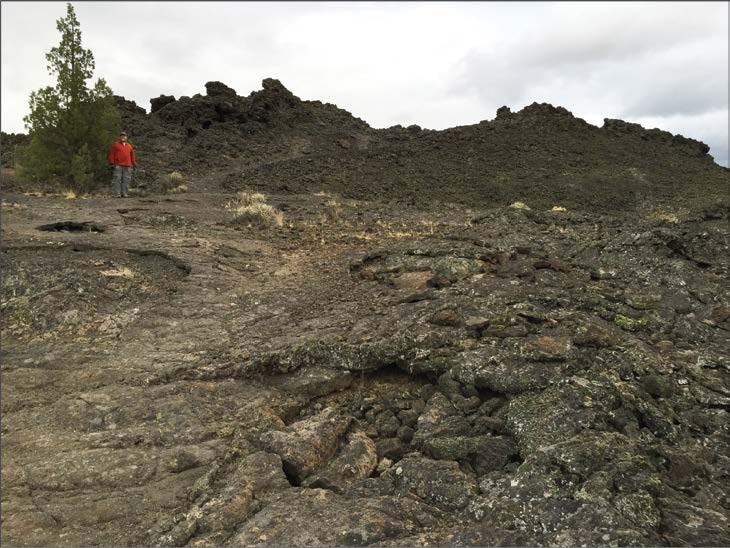
USGS photo.
Lava tubes are present in basaltic lava flows erupted from fissures in several national park sites including Craters of the Moon, El Malpais, and Lava Beds national monuments.
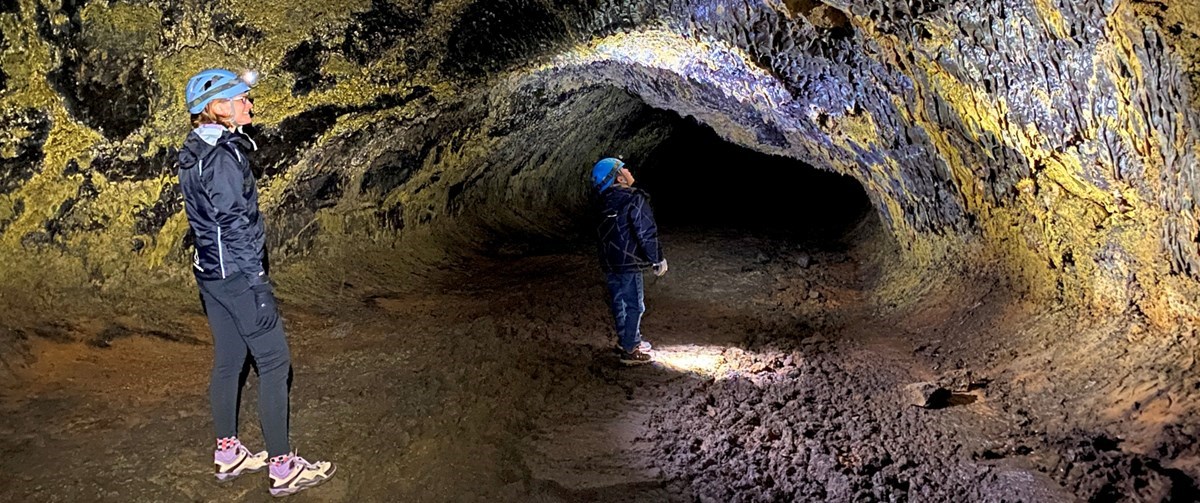
Spatter cones are steep-sided low cones made up of spatter. Spatter is also known as agglutinate and is an accumulation of fused-together volcanic bombs that landed while they were still molten. These bombs weld together to form solid rock that builds up around vents that erupt in Hawaiian style eruptions (VEI 1). Spatter cones are usually small (generally less than 33 ft; 10 m). Linear groups of spatter cones are commonly found along fissures.
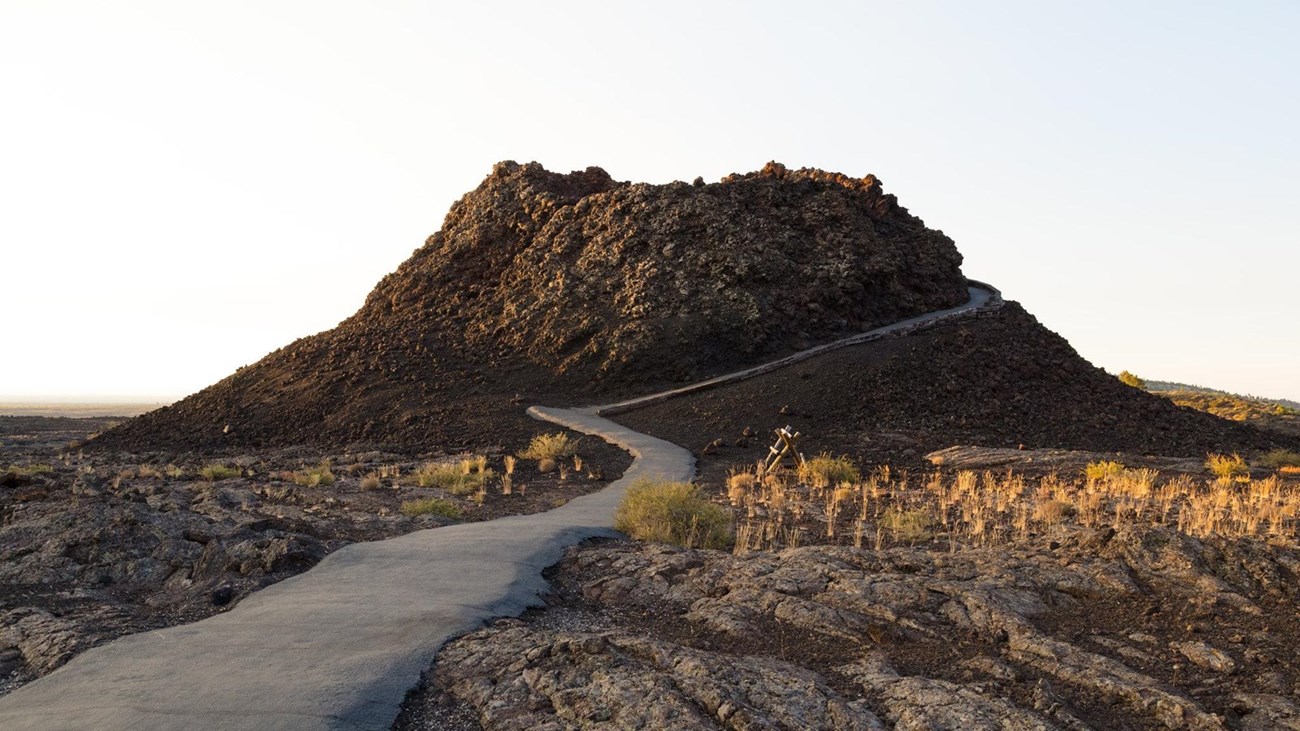
Individual eruptive fissures may only experience one period of activity, but areas that have fissure volcanoes including monogenetic volcanic fields and the flanks of shield volcanoes experience multiple eruptions.
New fissure eruptions may occur near existing fissure volcanoes. Precursors to fissure eruptions include earthquakes and rumblings (subterranean noises).
Geohazards on and around existing fissure volcanoes include rough uneven ground, fracture systems, crevasses, and lava tube caves.
Craters of the Moon National Monument, Idaho—[Geodiversity Atlas] [Park Home] [npshistory.com]
El Malpais National Monument, New Mexico—[Geodiversity Atlas] [Park Home] [npshistory.com]
Lava Beds National Monument, California—[Geodiversity Atlas] [Park Home] [npshistory.com]
Petroglyph National Monument , New Mexico—[Geodiversity Atlas] [Park Home] [npshistory.com]
Part of a series of articles titled Volcano Types.
Previous: Maars and Tuff Rings
Last updated: December 6, 2024